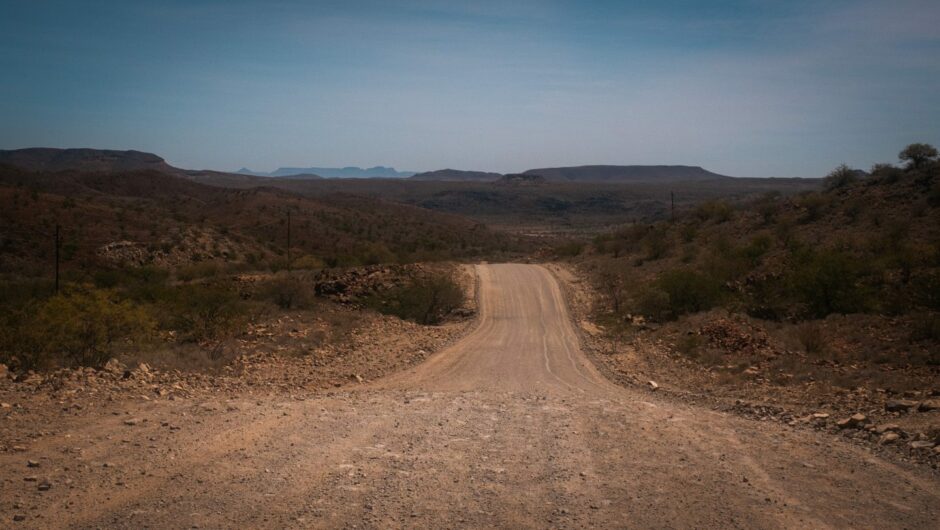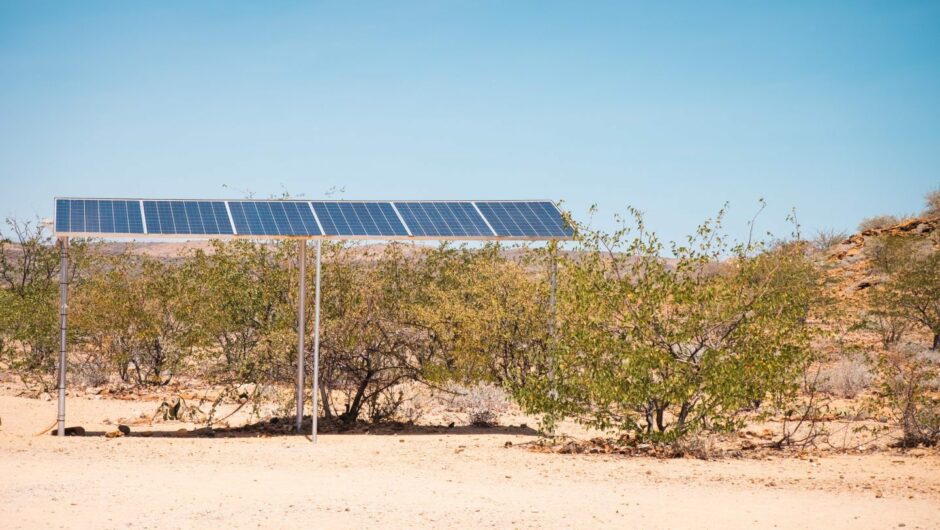 © Edward Reed/DCT Media
© Edward Reed/DCT Media Europe needs new sources of energy, particularly zero carbon energy, while Namibia offers abundant solar and wind. Can hydrogen bridge the gap, providing scope for both to prosper on the route to net zero?
A number of companies, and governments, believe it may just work.
“There’s a lot of enthusiasm in the market but there’s no way around hydrogen. Either we use it, or we all get cooked,” Siggi Huegemann, co-founder and Secretary General of African Hydrogen Partnership (AHP), said.
The challenge for Europe is the degree to which industries are reliant on fossil fuels. Transport, buildings and industry are made possible, in their current forms, by fossil fuels.
“Certain areas cannot decarbonise with batteries, it’s an illusion. We need hydrogen – or hydrogen derivatives – and it’s technically feasible. There’s nothing else there,” Huegemann said.
Hydrogen and more electrification are not mutually exclusive, he continued, saying there was clear scope for them to complement each other.
European need
The need for hydrogen has been apparent for some time. Recent developments, most particularly increasingly strong gas prices and Russia’s invasion of Ukraine.
The European Commission has said there is a “double urgency”, of decarbonisation and curbing reliance on Russian gas. As such, it has launched its REPowerEU plan. This aims to secure 10 million tonnes per year of domestic green hydrogen and the same amount again of imports by 2030.
European Investment Bank (EIB) senior investment officer Juliette Leusink, speaking at the Africa Energies Summit recently, said hydrogen was “going to be the future”.
Substantial interest in pursuing the hydrogen goals has meant “there’s a lot of large stakeholders involved and money available to make this a success”.
Exploring links
Namibia aims to capture some of this interest. A number of African states – and beyond – have set out their stall to seize the hydrogen zeitgeist.
The Southern African state is going the extra mile with put political weight behind its plans. Namibian President Hage Geingob has overseen a number of agreements with European ports on supplies. He has also appointed a Hydrogen Commissioner who reports directly to him.
Namibia participated in the launch of the Africa Green Hydrogen Alliance in mid-May, along with South Africa, Egypt, Morocco, Kenya and Mauritania.
“Solar and wind are now the cheapest forms of generating energy – and Namibia has an incredible combination of these two,” Tobias Bischof-Niemz, director at Enertrag Southern Africa, said.
“Namibia gets around 2,600-2,800 full-load hours of solar per year, versus 1,000 full-load hours in Germany. We expect wind turbines to get 50-60% utilisation, which is better than in the North Sea.”
Obvious role
Gordon Stewart, partner at Bracewell, said Germany in particular was concerned about its exposure to Russian gas and the impact on its industrial economy.
The state has recently announced plans to launch LNG infrastructure that can also offtake hydrogen supplies.
“The Bundestag underwriting significant offtake would underpin the significant capital investment by both equity and project finance debt, depending on the terms of the support,” Stewart said.
“When coupled with its historic ties to Namibia, there seems an obvious role for the German government to be able to play in supporting the development of Namibian green hydrogen whilst also serving its energy security needs.”
Namibia has a “number of natural advantages, including excellent renewable resources in the form of solar irradiation and wind resource”, Stewart said. “Namibia has been steadily expanding its renewable generation capacity through public tenders although most hydrogen projects are aiming to construct captive power solutions for their electrolysers.”
Bridging the gap
One project that aims to pioneer green hydrogen in Namibia is the Hyphen project.
“The world needs as much hydrogen it can get as fast as possible,” said Hyphen CEO Marco Raffinetti. “Our plant will produce about 300,000 tonnes per year of hydrogen, that’s about enough for one large steel plant.”
For Europe to meet its import needs, the group must focus investment on the countries that offer the best prospects, Raffinetti said. Namibia fits this bill, he said.
“In these early stages, it’s critical to go to the best locations in the world to drive costs down and maximise energy and hydrogen yield from every solar panel, every wind turbine, every electrolyser deployed.”
The Hyphen plan involves the construction of a facility around 80 km from the port of Luderitz. It would split desalinated seawater, exporting hydrogen as ammonia back to the port.
Local banks, even in the broader Southern African region, lack the capacity to be able to finance such a multi-billion dollar plan. European banks and export credit agencies (ECAs) would have to step up to support these projects.
Hyphen aims to capitalise on this sense of urgency.
“We’re the preferred bidder and we’re in pre-planning. Full engineering designs can only start once legal agreements are finalised – we aim to reach that this year,” Raffinetti said. “The goal is to start supplying hydrogen by the end of 2026.”
Making moves
One of the challenges facing exports from Namibia – and other areas – is the question of transportation. Where natural gas can be chilled into LNG at -160 degrees Celsius, hydrogen must be cooled to around -253 degrees.
Bracewell’s Stewart described the transportation distances as “considerable”, particularly when end user demand for green hydrogen is limited.
“The lack of a large scale proximate end use case for Namibian hydrogen then adds the cost of transportation into the project economics as well as considerations as to the round cycle efficiency of green hydrogen where it is intended to be transported and converted back into electricity again,” he said.
Furthermore, Namibia would require “significant upgrades to logistical infrastructure such as railways, pipelines and bulk terminals … to reach international markets”.
The industry seems to have largely moved to backing ammonia as a transportation vector for hydrogen. Transportation protocols for ammonia are widely established and operators can produce it fairly simply through the addition of nitrogen to hydrogen.
“Ammonia from Namibia will have a 40% cost advantage to that produced in Central Europe, and a 25% advantage to other areas,” said Enertrag’s Bischof-Niemz.
Once landed, ammonia can be cracked back into hydrogen, but this does loose more energy. The alternative would be to use ammonia direct.
Trade offs
The AHP’s Huegemann said it was “not an easy thing to transport from production to demand. The closer one is to demand the better.” At a distance of less than 5,000 km, piping hydrogen is the cheapest method, he said.
However, Europe is likely to seek a diverse range of sources in order to bolster energy security after learning a painful lesson on Russian gas. The group expects to import 6mn tonnes of hydrogen by 2030, with another 4mn tonnes in ammonia.
“Green hydrogen from Africa will price blue out, we can be relaxed about it,” Huegemann said. “There’s no way around it. Europe cannot decarbonise without green African hydrogen – it’s not possible.”
Afry has forecast low carbon hydrogen will rise from 94mn tonnes in 2030 to 389mn tonnes in 2050. Solar will come to play an increasingly important role in this, accounting for 57% of 2050 output.
Local needs
A low carbon hydrogen forecast from Afry has suggested that distance to market was critical for success or failure. Those areas that are far from demand hubs, it said, may only produce hydrogen to meet domestic demand.
There are some opportunities for local consumption, most notably in South Africa. Sasol, with Air Liquide, is in the process of ramping up local production to meet its needs at Secunda. Furthermore, South Africa is working on green hydrogen plans of its own.
“Namibia has the potential to leverage some of the increased domestic capacity of South Africa manufacturing and industrial capacity,” said Stewart. However, South Africa’s renewable energy rounds “are already pushing that manufacturing supply chain to its maximum capacity”.
Hyphen’s Raffinetti made the case that South Africa would serve as a natural customer for Namibia’s green hydrogen, via pipeline.
“South Africa has its own decarbonisation plans and Namibia could be a key ally to the extent that South Africa is unable to achieve its decarbonisation goals on its own,” he said.
Namibia clearly has an attractive renewable resource and a government eager to drive development. Weighing against this, though, is the distance to market. Given European need to diversify supply, it may be that transport costs are a price worth paying for energy security.

